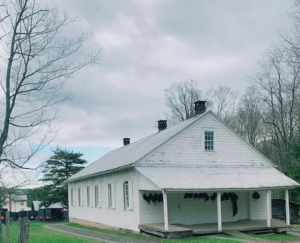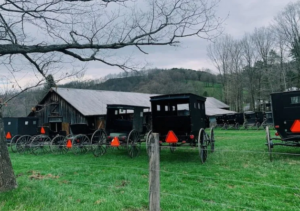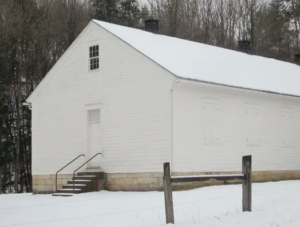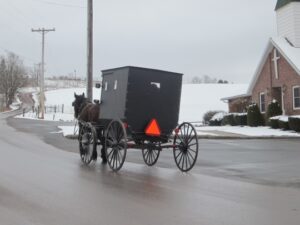by
Erik Wesner
April 20, 2021 in
AmishAmerica.com
edited with Introduction by
Larry Pearce
My wife Susan’s Amish ancestors were among the first settlers in southern Somerset County, PA, and western Maryland. As members of the Casselman Historians, we’ve been fortunate over the years to visit those communities, including the churches, the cemeteries, and even the homes of the Amish-Mennonite members and Susan’s associated relatives. I’ve written and re-posted many articles on their rich traditions. See the “Table of Content: Lee” and other Krause-related family sites. What follows is yet another fascinating article by Erik Wesner, this time with references to other authors familiar with the Amish practices:
Revised article from AmishAmerica.com
In a recent e-mailed post on five Amish religious practices, I included the custom of home worship. I noted there are some exceptions, linking to my post on the Somerset County, PA Amish community. As it happens, a local writer named Layne Deakins recently published an article about her visit to this same settlement.
Somerset County is one of the most intriguing of Amish settlements – it’s small and not especially well-known, but it has an important history as a “seed settlement” for other large and significant Amish communities (including Holmes County and Arthur, Illinois). It also has the unusual distinction of being one of the few Amish groups which use meetinghouses for worship (rather than pre-existing structures common to Amish homes, like workshops, basements, or barns).
In her article, Layne mostly gives general Amish info rather than a lot of specifics about Somerset County. But of most interest to me, she does provide a couple of photos from the community, including of the Summit Mills Meetinghouse. It looks like she happened to be there when a church service was going on: Photo: Layne Deakins/jetsettimes.com
Photo: Layne Deakins/jetsettimes.com
Here is a second photo showing the buggies parked outside and revealing the area’s hilly terrain. A reader with local ties named Carol Yoder writes that “the long, low shed is for all the horses. They are unhitched and taken inside, while the buggies remain outside.”
 Photo: Layne Deakins/jetsettimes.com
Photo: Layne Deakins/jetsettimes.com
Little if anything has changed in the six years since I first visited this meetinghouse. We see a wide front porch and three separate chimneys. Six windows can be seen along the length of the building. Note two separate entrance doors in the front. You can also see what appear to be women’s bonnets (not the lighter-material prayer covering, but the large dark covering that goes over that) hanging on hooks on the outside of the church house: This is the view of the single door at the rear of the building to get to the hitching posts at the conclusion of the service. Above is a window, probably for ventilation in the summer:
This is the view of the single door at the rear of the building to get to the hitching posts at the conclusion of the service. Above is a window, probably for ventilation in the summer: The meetinghouse resembles a large Amish school building. If you’d like to see what one looks like inside, popular author Suzanne Woods Fisher has some interesting photos from the interior of a second Somerset County meetinghouse here.
The meetinghouse resembles a large Amish school building. If you’d like to see what one looks like inside, popular author Suzanne Woods Fisher has some interesting photos from the interior of a second Somerset County meetinghouse here.
The Summit Mills structure is one of the community’s two oldest meetinghouses (both having been built in 1881). The community’s other two existing Amish meetinghouses were not built until over a century had passed. It’s possible another may have been built since my 2015 visit, but I don’t know for sure. Besides these, apparently there were other early Amish meetinghouses, at least two of which became Mennonite church buildings in the late 19th/early 20th century following a schism.
Why meetinghouses?
There are at least a couple of stories as to why Amish built meetinghouses here. Here is one of them, via reader Phoebe (Beachy) Wiley, a Somerset Countian:
…the story I know about the reason for building meeting houses is that rowdies showed up when it was time to eat, and when one of them knocked a young Amish boy off the porch and broke his arm, the leaders said, “Dass ist genunk!” (That is enough!), and they built four church houses, two of which (Niverton and Summit Mills) are still in use.
The other, similar version of the story has to do with rowdy coal miners. This is from the community’s church directory:
In the 1880’s Somerset County had a lot of coal miners living in the area. Since they had no work on Sunday they made a nuisance of themselves at the homes where church was being held. They’d go into the orchards and throw apples around; also messing with the food in the basement. This is what prompted our forefathers to build church houses.
End of AmishAmerica.com article
A tale about Susan’s Great-grandfather Christian “Crist” Lee and the Niverton miners has been handed down. It doesn’t tell if there’s a connection to the community building meethouses, but it’s interesting none the less. My feeling is that, as the community grew in size and materials were available, meetinghouses became more practical. That will be a good question for this September’s meeting of the Casselman Historians.
Last revised 4/21/21

